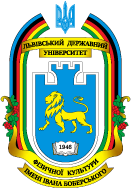SPECIFICS OF REHABILITATION OF PEOPLE AFTER LOWER LIMB AMPUTATION: A REVIEW OF SCIENTIFIC LITERATURE IN THE PERIOD 2022–2024
DOI:
https://doi.org/10.32782/2221-1217-2025-1-08Keywords:
rehabilitation, lower limb amputation, physical therapy, therapeutic exercises, mirror therapy, stages of rehabilitation resocializationAbstract
The study analyzes 16 scientific publications related to the rehabilitation of patients after lower limb amputation. The main stages of rehabilitation and the peculiarities of forming an individual recovery plan are determined. The central physiological and mental problems of individuals after lower limb amputation are demonstrated. The main ways of preventing or localizing the risks associated with lower limb amputation and the process of rehabilitation are identified. The aim and objectives of the study are achieved through the use of the following methods or approaches: chronological; systematic; criticalanalytical; selective. The study showed that physical therapy after lower limb amputation consists of preoperative and postoperative stages. It has been revealed that consistent, moderate and constant exercise according to the rehabilitation plan helps to achieve the highest possible independent functioning of a person, improves muscle endurance and limb coordination, allows to develop the highest possible level of balancing and is the key to the possibility of resocialization and reintegration into social life. Lifelong medical monitoring and psychological support play an important role. We also want to highlight adaptive sports as an integral means of rehabilitation in the later stages. It helps to develop the following physiological indicators of a person: endurance; flexibility; muscle tone; coordination of movements. The article shows that the central problems that limit an individual after amputation of the lower limb are the following: functional-behavioral or bodily features; psycho-emotional state of the person; lack of social infrastructure adapted to the needs of individuals with limited mobility. It is determined that the rehabilitation plan of an individual, regardless of the level of lower limb amputation, should be individualized and take into account the current physiological and psychological characteristics of the patient.
References
1. Алгоритм реабілітації пацієнтів після ампутації нижньої кінцівки / Кірєєв та ін. Сучасні питання фізичної реабілітації, рекреації та фізичного виховання різних груп населення. 2022. С. 17–19. URL: https://dspace.nuph.edu.ua/bitstream/123456789/28661/1/17-18.11.%2022%20Тези%20Алгоритм%20реабілітації%20...%20.pdf
2. Левков А., Климченко В. Ампутація нижніх кінцівок у військових та фізична реабілітація після неї. Медична реабілітація в Україні: сучасний стан та напрями розвитку, проблеми та перспективи: матеріали ІV Всеукраїнської науково-практичної конференції з міжнародною участю, 52–56. 2024. URL: https://reposit.nupp.edu.ua/handle/PoltNTU/17622
3. Мерзлікіна О.А., Трясун Ю.Р., Коваленченко В.Ф. Програма фізкультурно-спортивної реабілітації військовослужбовців після ампутації нижніх кінцівок у реабілітаційному центрі. Цифровий репозитарій Українського державного університету імені Михайла Драгоманова. 2024. URL: http://enpuir.npu.edu.ua/handle/123456789/44951
4. Нагорна О., Дехтерук В. Фізична терапія хворих після ампутації нижніх кінцівок. Реабілітаційні та фізкультурно-рекреаційні аспекти розвитку людини (Rehabilitation & Recreation) 2020. № 6. URL: https://health.nuwm.edu.ua/index.php/rehabilitation/article/view/87
5. Філоненко В. Фізична терапія осіб після ампутацій нижніх кінцівок (Магістерська кваліфікаційна робота). Київ, 2023. URL: https://reposit.uni-sport.edu.ua/xmlui/handle/787878787/4741
6. Цюпак Т., Цюпак Ю., Драченко В. Реабілітаційні заходи після ампутацій нижніх кінцівок. Молодіжний науковий вісник Східноєвропейського національного університету імені Лесі Українки. 2019. № 19. С. 152–156. URL: https://sportvisnyk.vnu.edu.ua/index.php/sportvisnyk/article/view/392
7. Юшковська О.Г., Середовська В.Ю. Сучасні проблеми адаптивної фізичної культури та адаптивного спорту. Сучасні аспекти комплексної реабілітації. Виклики та перспективи: Матеріали науково-практичної конференції, м. Одеса. 2024. URL: https://repo.odmu.edu.ua/xmlui/handle/123456789/16097
8. Hijmans, J. M., Dekker, R., & Geertzen, J. H. B. (2020). Pre-operative rehabilitation in lower-limb amputation patients and its effect on post-operative outcomes. Medical Hypotheses, 143, 110134. https://doi.org/10.1016/j.mehy.2020.110134 DOI: https://doi.org/10.1016/j.mehy.2020.110134
9. Hordiichuk, S. V., et al. (2024). Actual issues of the development of physical rehabilitation in Ukraine. Ukraine. Nation’s Health, (2), 132–140. https://doi.org/10.32782/2077-6594/2024.2/22 DOI: https://doi.org/10.32782/2077-6594/2024.2/22
10. IREX. Програма реінтеграції ветеранів. 2021. URL: https://www.irex.org/sites/default/files/Veterans’%20Benefits%20Utilization%20and%20Experiences%20–%20Ukrainian.pdf
11. Miller, M. J., et al. (2020). Patterns of sitting, standing, and stepping after lower limb amputation. Physical Therapy. https://doi.org/10.1093/ptj/pzaa212 DOI: https://doi.org/10.1093/ptj/pzaa212
12. National Institute for Health and Care Excellence (NICE). (n.d.). Rehabilitation after traumatic injury. URL: https://www.nice.org.uk/guidance/ng211
13. Pancevski, B. (n.d.). In Ukraine, amputations already evoke scale of World War I. The Wall Street Journal. URL: https://www.wsj.com/articles/in-ukraine-a-surge-in-amputations-reveals-the-human-cost-of-russias-war-d0bca320
14. Shelmerdine, L., & Stansby, G. (2022). Lower limb amputation and rehabilitation. Surgery (Oxford). https://doi.org/10.1016/j.mpsur.2022.05.015 DOI: https://doi.org/10.1016/j.mpsur.2022.05.015
15. Slukhenska, R., et al. (2023). Complex of measures regarding the physical rehabilitation of military servants. Scientific Journal of National Pedagogical Dragomanov University. Series 15. Scientific and Pedagogical Problems of Physical Culture (Physical Culture and Sports), 1(159), 130–132. https://doi.org/10.31392/npu-nc.series15.2023.1(159).31 DOI: https://doi.org/10.31392/NPU-nc.series15.2023.1(159).31
16. The Management of Upper Limb Amputation Rehabilitation Work Group. (2022). VA/DOD Clinical Practice Guideline for Management of Upper Limb Amputation Rehabilitation. Washington, DC: U.S. Government Printing Office.
17. Wijekoon, A., et al. (2023). Quality of life, physical activity participation, and perceptions of physical rehabilitation among community-reintegrated veterans with lower limb amputation in Sri Lanka: A convergent parallel mixed methods study (Preprint). JMIR Rehabilitation and Assistive Technologies. https://doi.org/10.2196/52811 DOI: https://doi.org/10.2196/preprints.52811
18. Yevchenko, D. O., et al. (2023). The mirror therapy effectiveness as a part of physical rehabilitation program of servicemen after lower limb amputation due to mine-explosive injury. Ukrainian Journal of Military Medicine, 4(4), 60–68. https://doi.org/10.46847/ujmm.2023.4(4)-060 DOI: https://doi.org/10.46847/ujmm.2023.4(4)-060






